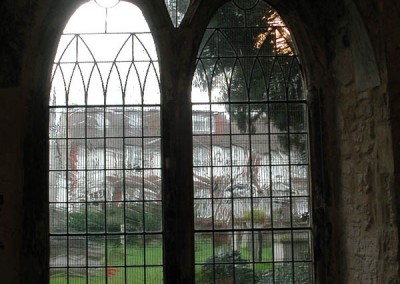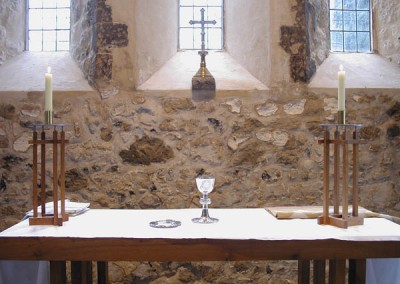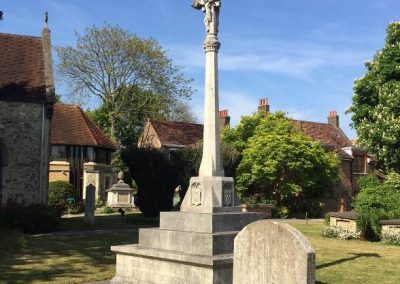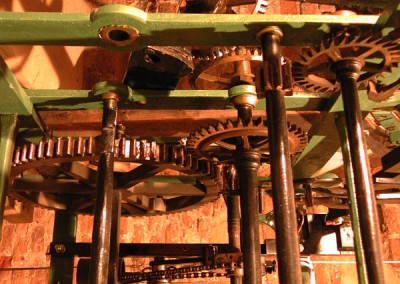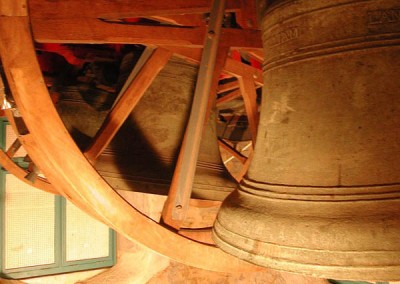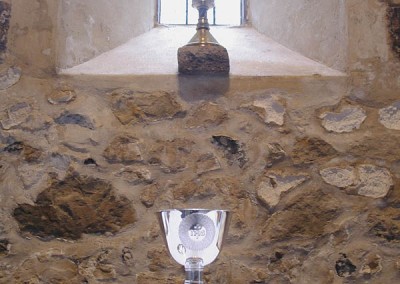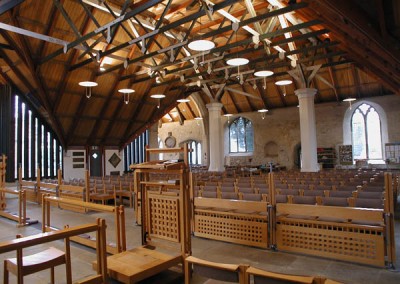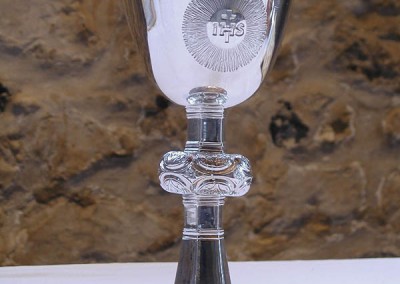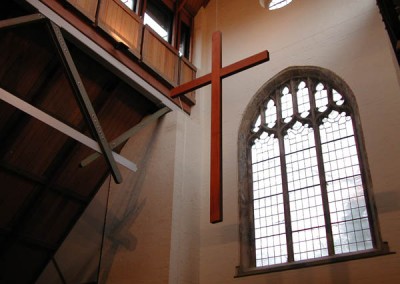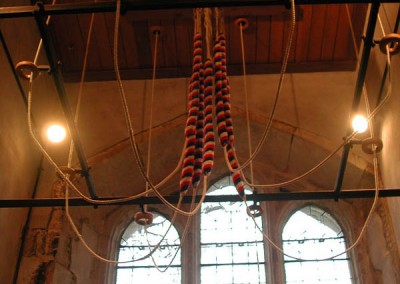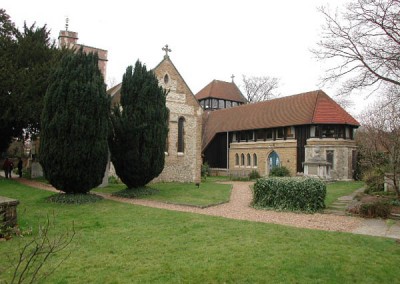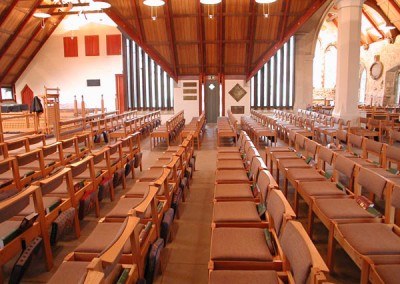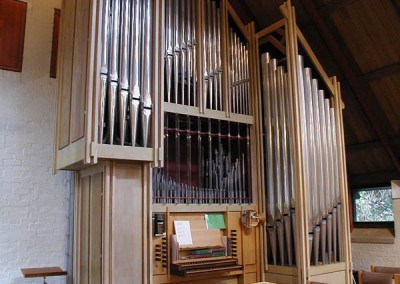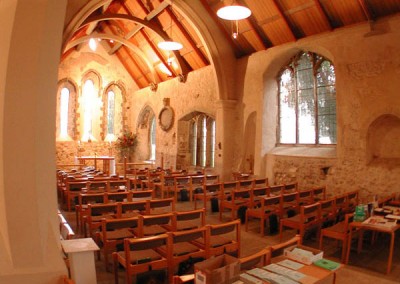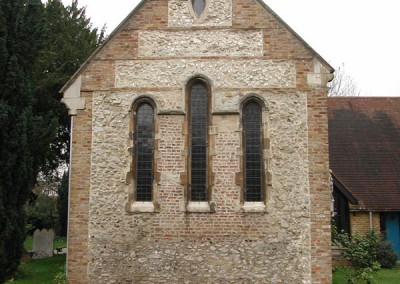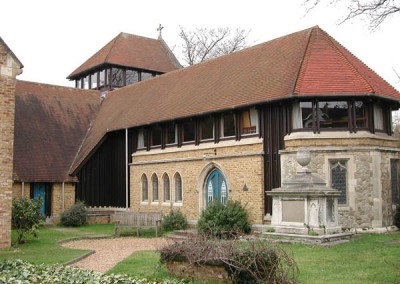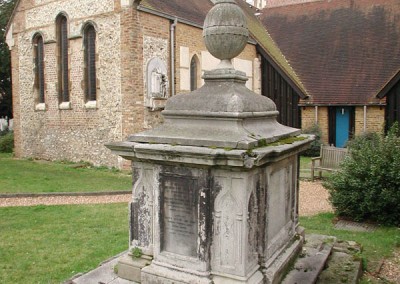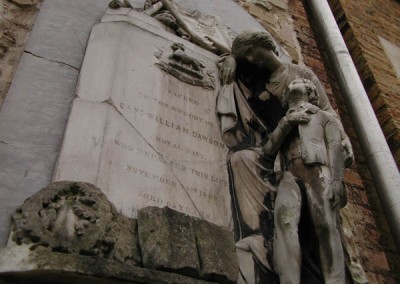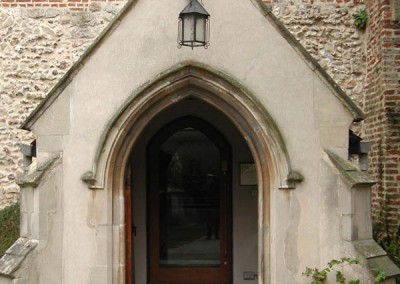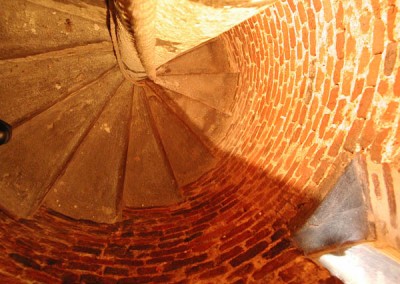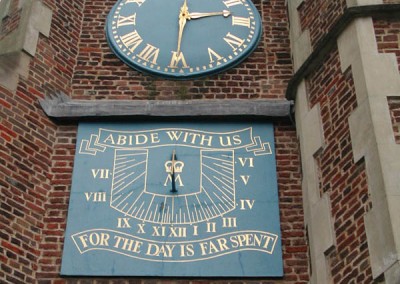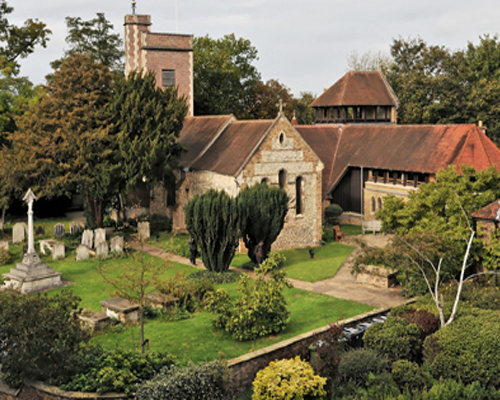
The Church of St Mary, Barnes has a Grade 2* listing. It dates from around the time of the Domesday Book. Over subsequent centuries the fabric was extended and altered successively in response to changing needs and a growing congregation.
In 1978 the church was largely destroyed by fire and designs were developed for a new church. This occupies the site of its predecessors and incorporates elements of historical significance and architectural distinction, notably the south wall, east gable, vestry, northwest turret and tower.
In 1984, following rebuilding, the church was rehallowed, with the tower being subject to further, external, restoration in 1990. The church forms part of the outstanding conservation area of Barnes Green, and stands within an extensive walled and gardened churchyard, with specimen yew tree and lych gate entrance.
Founding of the Church
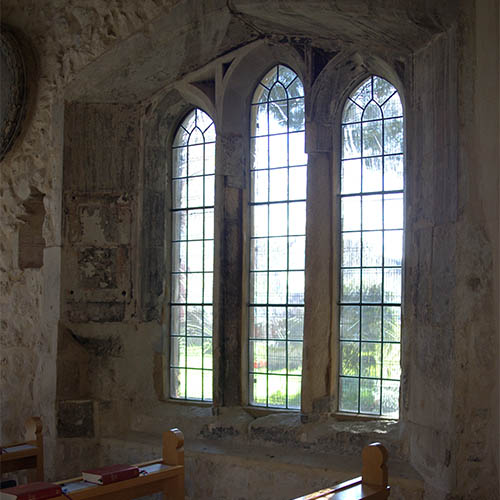
At some time between 1100-1150AD, a simple rectangular chapel dedicated to the Virgin Mary was built in the small, sparsely populated Thameside village of Barnes, Surrey. The walls of the chapel were composed mostly of coursed flint. An early 13th century addition to the west enlarged the nave, while another to the east added a chancel with triple lancet windows.
The next important structural addition to the church was the brick-built west-tower, c1485; this was to be the last notable change until the demolition of the north wall in 1786 made way for a north aisle, side by side with the medieval chapel. The total seating was now 460.
Early 19th century improvements to road and rail transport between Barnes and London encouraged a steady increase in population and a growing demand for places at St. Mary’s resulting in further small changes followed by a major enlargement completed in 1906. The old north aisle became the enlarged central aisle and nave with a sanctuary and chancel to the east; the original 12th/13th century chapel became the Lady Chapel. Seating totalled 950.
Magna Carta
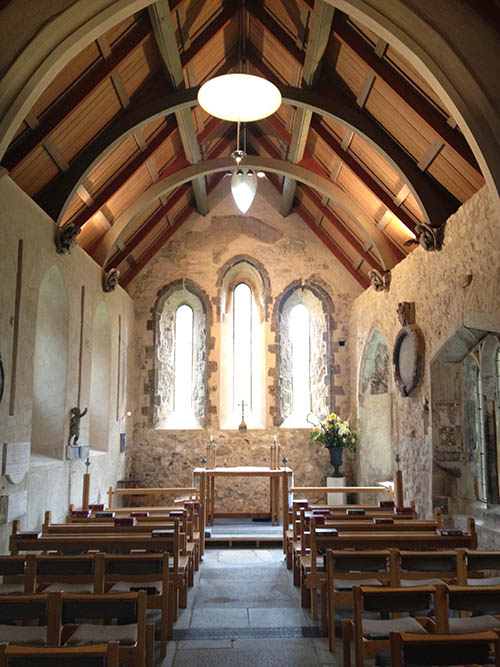
St Mary’s Barnes links with Magna Carta through Archbishop Stephen Langton. As Langton travelled back to London along the river after the sealing of the Magna Carta by King John at Runnymede on 15 June 1215, he stopped at Barnes to dedicate St Mary’s Church. This is recognised by the title now given to the original medieval part of the church, The Langton Chapel, created at the time of the rebuilding of the church after the fire which decimated it in 1978.
Stephen Langton
Stephen Langton (c. 1150 – 9 July 1228) was an English Cardinal of the Roman Catholic Church and Archbishop of Canterbury between 1207 and his death in 1228. The dispute between King John of England and Pope Innocent III over his election was a major contributory factor to the crisis which produced the Magna Carta in 1215. Cardinal Langton is also credited with having divided the Bible into the standard modern arrangement of chapters used today.
Fire & Rebuilding

On June 8th 1978 fire nearly destroyed the church. The Victorian and Edwardian additions were lost but thankfully the Tudor tower survived, as did much of the original chapel, with several previously hidden features from the 12th and 13th centuries revealed as a direct result of the fire.
These features were skilfully incorporated into plans for the re-built church by architect, Edward Cullinan. They are now an integral part of the re-built and revitalised church.
St. Mary’s was re-hallowed at a service on February 26th 1984. The oldest surviving part of the original church, the Lady Chapel, was then re-named the Langton Chapel in celebration of the events of c1215.
Churchyard
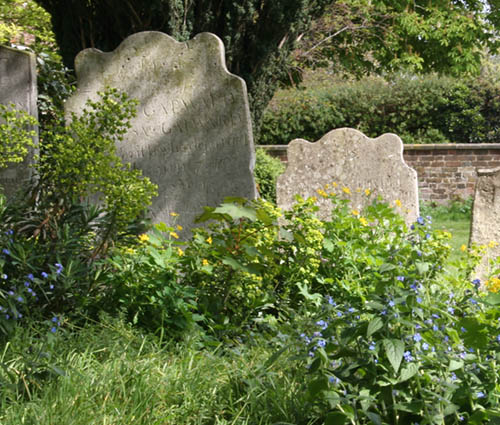
The churchyard at St Mary’s is fascinating to explore. Archeologist Scott McCracken has suggested that burials began on the site in medieval times. However, most of graves you see today date back to the 17th, 18th and 19th centuries. The earliest dated memorial plaque belongs to Edward Rose who was buried on 7th July 1653, and other notable inhabitants of the churchyard include Captain Dawson (1795-1859) claimed to be the younger of two sons born to Mrs Maria Fitzherbert and the Prince Regent (later George IV), and Sir Lancelot Shadwell (1779-1850), the last Vice Chancellor of England, father to 17 children by two wives. He is said to have bathed daily in the lake at Barn Elms.
The churchyard is also a place of peace. At certain times of the year we let the land grow fallow to encourage wildlife. However we also maintain other areas to a very high standard and beautiful cottage-style planting includes hollyhocks and roses. We have some magnificent trees including a specimen yew and a spectacular magnolia.
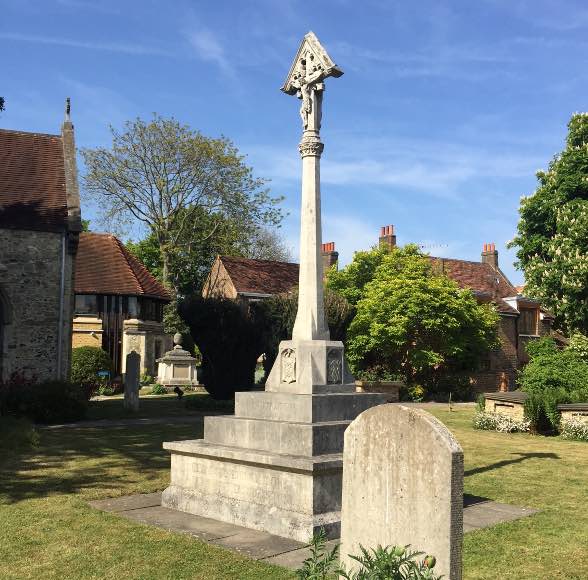
Barnes War Memorial in the churchyard was given Grade II listing in 2017 as part of the War Memorials Listing Project to mark the centenary of the First World War.
The war memorial has a tall octagonal stone shaft surmounted by a decorated gable with a sculpture of Christ. This rests on a plinth, each face of which bears a decorated shield hanging from a flower, representing the instruments of the Passion. These depict the Crown of Thorns, with crossing Holy Sponge and Holy Lance; the hammer and tongs used to nail Christ to the cross, with dice representing the casting of the lots for Jesus’s robes; the Cross; and the pillar and whips, representing the flagellation of Christ. This rests on a two-step plinth, the front faces of which bear the inscriptions “1914 1919 and 1939 1945” and “Our Glorious Dead”.
The memorial was unveiled on 19th June 1921 in a ceremony attended by Field Marshall Sir John French. As part of the church and churchyard, it is well maintained by funds generated by the activities of The Friends of St Mary’s Barnes and is the centrepiece for the annual Remembrance Day service in November each year.
Scrap Books
Before records were kept digitally, St Mary’s made scrapbooks of pictures, articles, sermons and much more, recording the life of the church over a year. We have recently scanned this precious archive and you can access scrapbooks covering the years 1978 to 1989 it by clicking the button below.
Hoare plaque
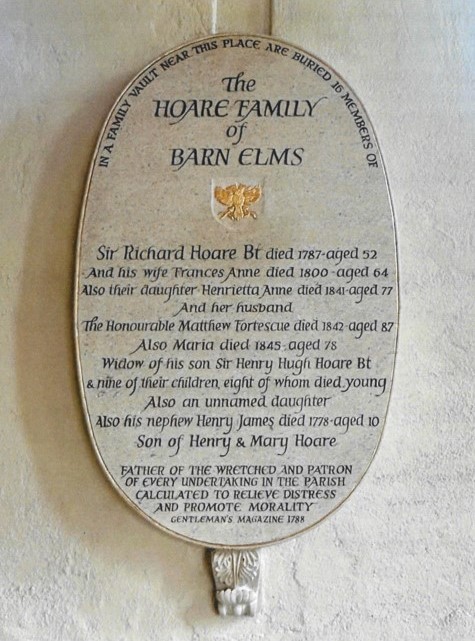
In April 2023 a new plaque on the north wall of the Langton Chapel was dedicated to sixteen members of the Hoare family who had been buried in a family vault in the church between 1779 and 1845.
Sir Richard Hoare, a banker, was brought up on the Barn Elms estate which his father, also Richard, had bought in 1742. In 1777 Sir Richard was given permission to demolish the north wall of the nave of the old church and extend into the churchyard to provide a gallery with seating for his family with pews below for his servants, the Hoare family chapel, at his own expense. The burial vault was created beneath the chapel. Nine of those buried were children of his son Henry Hugh and his wife Maria who pre-deceased their parents.
The plaque is inscribed ‘FATHER OF THE WRETCHED AND PATRON OF EVERY UNDERTAKING IN THE PARISH CALCULATED TO RELIEVE DISTRESS AND PROMOTE MORALITY’ (Gentleman’s Magazine 1788).
None of the bank’s partners or those memorialised were directly involved in the slave trade. Hoare’s Bank, however, like the Church of England and many other institutions, has a long history and would have benefited form profits derived from the slave trade prior to abolition. St Mary’s Barnes, together with all of the Church of England is seeking to learn the lessons of history and actively apply these to the future.
Please follow these links if you would like to know more about the history of the Hoare family in Barnes and the church’s response to the issues the plaque raises..

